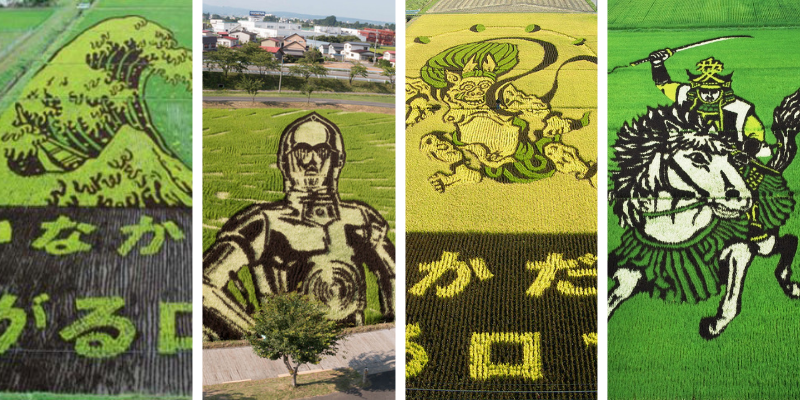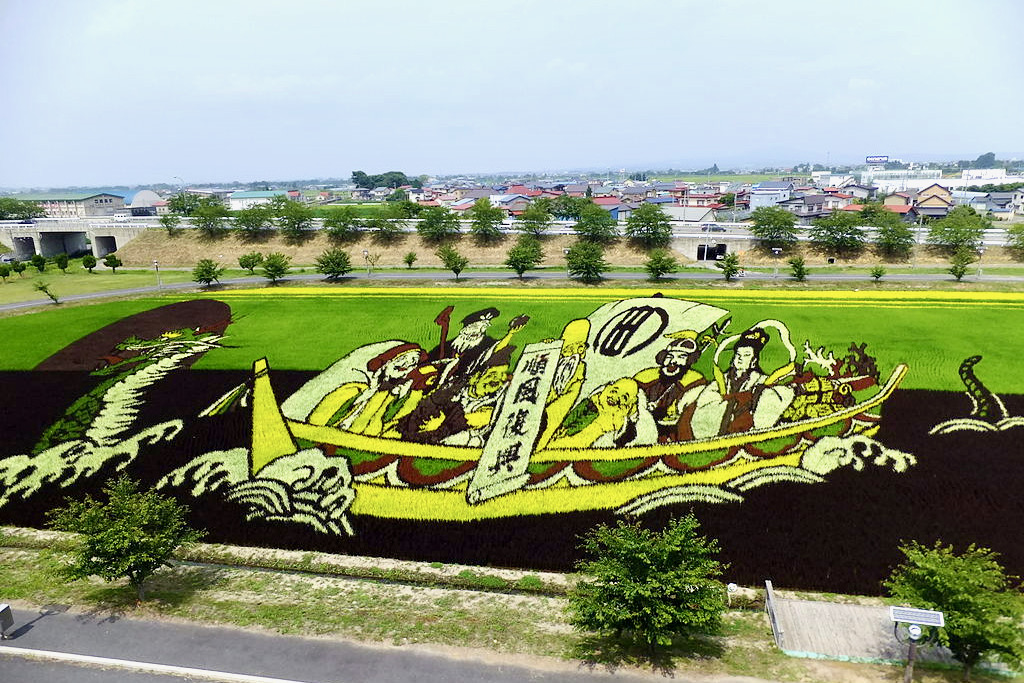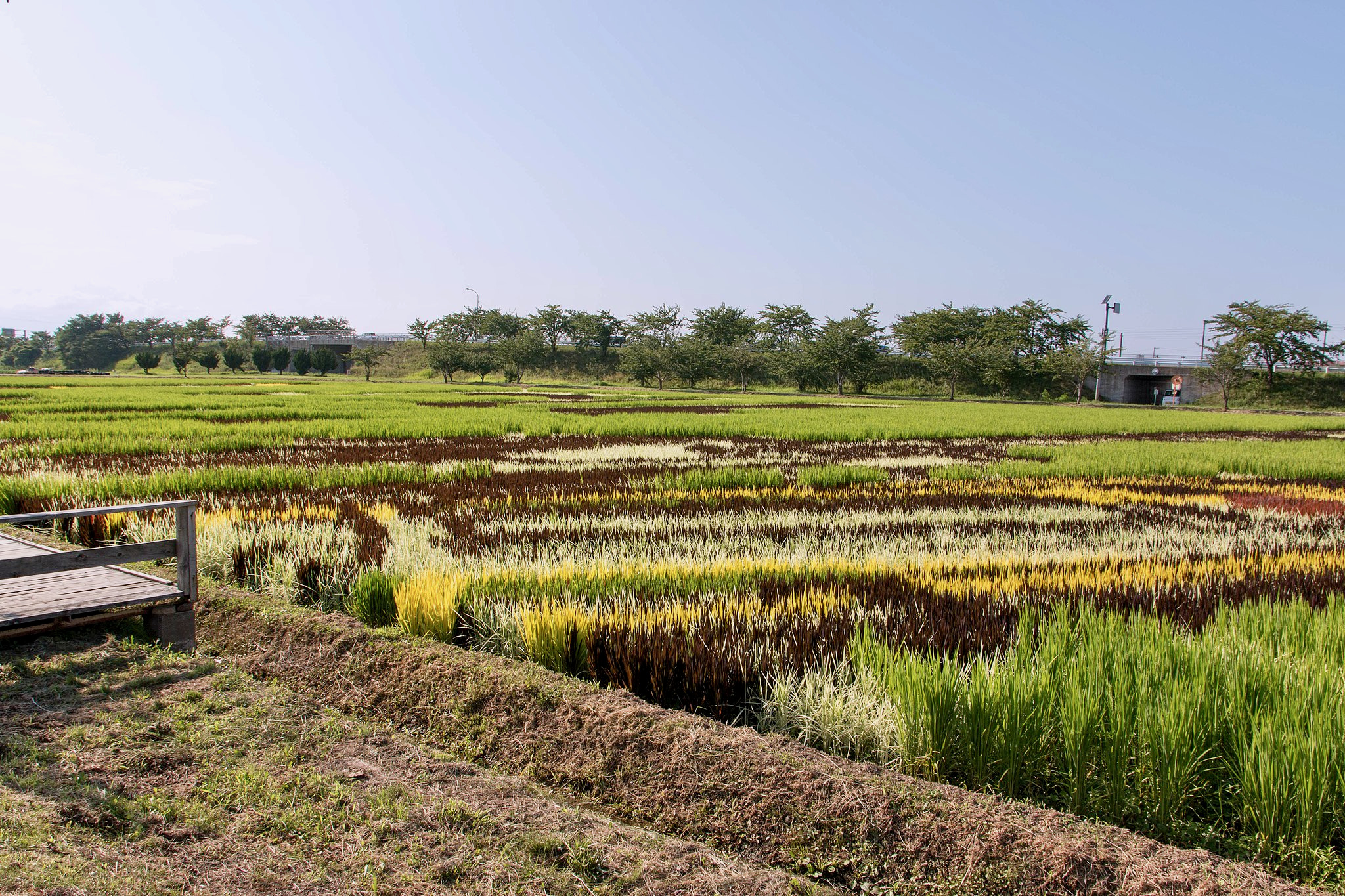JAPAN
Planting a Painting
By Rachel Fruin
Naperville, IL, United States
Sometimes the best ideas come from failure.
In 1981, archaeologists digging near Inakadate, Japan, discovered evidence of rice cultivation dating back 2,000 years. Hoping to lure tourists, this small town of about 8,000 residents built an amusement park based on New Stone Age history. The tourists failed to arrive, however, and by 1993, US$106 million of debt forced town leaders back to the drawing board.
Going with the Grain
A clerk in the town hall had the ingenious idea to honor Inakadate’s rice-growing legacy by using fields nearby as a blank canvas for painting in rice. Including four strains of this staple in hues of yellow, white, dark red, and green, villagers planted the paddy according to precise coordinates. From May to October, as the rice grows, an image emerges. As the rice matures, the colors deepen.
At first only simple designs were used, such as the outline of a mountain with some kanji (characters in Japanese writing). As the tanbo paddy art grew in popularity, so did the villagers’ skills, resulting in more complicated illustrations that change every year. From geishas to Godzilla to Gone with the Wind, current designs attract hundreds of thousands of tourists.
Volunteer Venture
Inakadate officials built a 22-meter observation tower attached to the town hall that allows access free of charge. Donations are accepted, however, to cover the US$35,000 cost of renting the land. The labor of planting and harvesting is contributed by local residents, even though it can take 1200 people to produce one design. Meticulously covering 15,000 square meters with seedlings is a lot of work!

A New Perspective
A notable year was 2003 when planners attempted to draw more visitors by recreating Leonardo da Vinci’s famous Mona Lisa. Although a successful reimagining, because the vertical perspective hadn’t been accounted for, visitors thought her head looked too small for her body. That’s when planners learned that they needed to skew the drawing so that it looked proportional from the viewer’s angle.
The success of Inakadate has led other rural Japanese towns to requisition rice paddies for artistic revenue generation. Although each site attracts tourists, any profit is relatively modest. Selling space for advertisements was considered only once and ultimately voted down, so the fields remain non-commercial testimonies to human enterprise, persistence, and creativity.
Have a suggestion for this story? We’d love for you to submit it!


Blank
Blank
Slideshows
Are you a teacher who’s interested in telling this story to your students? Here are two slideshows you can use to get started.
Math Resources
Learning Activity:
- Connecting to the Standards: Statistics and Probability (Grade 6)
- Connecting to the Standards: Geometry (Grade 7)
- Connecting to the Standards: Expressions and Equations (Grade 8)
Sample Problems:
- In 2010, Inakadate was US$106 million dollars in debt due to a failed amusement park and financial problems before that. It cost the village US$35,000 per year to rent the land, plant the seedlings, and maintain the rice crop. In 2010 the village brought in US$70,000 in donations from visitors who came to see the artwork. At this rate, when will they get out of debt? Design a graph with years along one axis.
- The village attracts 150,000 tourists every year. What could the village do to increase revenue and decrease debt? In groups, discuss strategies and draw up a budget of what your best option would look like.
- During one week, 21 people visit on Monday, 17 people on Tuesday, 13 people on Wednesday, 13 on Thursday, and 20 on Friday. What is the average number of people who come each day? Make a chart to identify a trend and explain why that trend might exist. What do you need to charge each person to make US$1000 per week?
- Design your own piece of art that covers a field that is x meters by y meters (you pick the values). If it typically costs US$9 to plant and grow a square meter of rice, how much with this piece of art cost?
- Imagine you have a park with 15 pieces of art that cost on average US$3500 each. The park also costs US$750 per day to maintain. How much do you need to make per day? If you have, on average, 80 visitors per day, how much do you need to charge them so that you make a profit of US$1250 per day?
Extension Question
What would you do with an abandoned amusement park? Believe it or not, across the globe, hundreds of now-defunct entertainment areas exist. If you owned one of these rusting locations, how would you turn a profit from it?
Explore Further
- News story on Inakadate’s Tanbo art
- Information on how rice grows
- News video showing rice paddies
Share Your Story
Write your own Global Math Story and send it to us!
Sorry, the comment form is closed at this time.